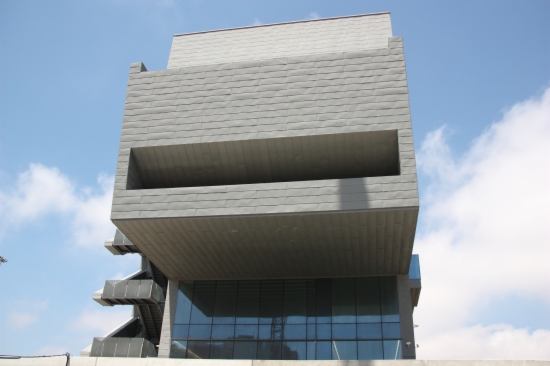Barcelona Design Museum opens with a 70,000 collection bringing together 4 museums
The Design Museum of Barcelona will open on December 14 and showcase the diversity of its collections and their origins, across 4 permanent exhibitions. The new centre, located within the DUHB building, will have a total collection of 70,000 items, coming from the previously existing Museum of Decorative Arts, the Ceramics Museum, the Textile Museum and the Cabinet of Graphic Arts. The aim of the new museum will be to "rediscover" the collections through a discourse that covers decorative and traditional arts, through industrial design, all the way to contemporary poster and graphic design. The DHUB is located in Glòries Square, in an area of Barcelona once known for its industry, but that has been recently opened up through extensive development and investment. According the Mayor of the city, Xavier Trias, the new museum "will reinforce the position of the square as an economic, social and cultural epicentre".

Barcelona (ACN).- The Design Museum of Barcelona will open on December 14 and showcase the diversity of its collections and their origins, across 4 permanent exhibitions. The new centre, located within the DUHB building, will have a total collection of 70,000 items, coming from the previously existing Museum of Decorative Arts, the Ceramics Museum, the Textile Museum and the Cabinet of Graphic Arts. The aim of the new museum will be to "rediscover" the collections through a discourse that covers decorative and traditional arts, through industrial design, all the way to contemporary poster and graphic design. The DHUB is located in Glòries Square, in an area of Barcelona once known for its industry, but that has been recently opened up through extensive development and investment. According the Mayor of the city, Xavier Trias, the new museum "will reinforce the position of the square as an economic, social and cultural epicentre". People will be able to visit the new museum for free until January 31.
The new Design Museum of Barcelona is located in the Barcelona Design Hub (DHUB), a recently-built building famous for its innovative and radical architectural design. The new museum has 6,000 square metres for permanent and temporary exhibitions, occupying part of the ground floor, as well as the upper floors. Besides, 900 square metres are dedicated to the the Documentation Centre, while 2,000 addition square metres will be used to store the collection itself, including 160 square metres for educational space and for outreach activities. The new facility will be the most recent addition to the building, which shares space with the FAD (Fostering Arts and Design) institution, the Barcelona Design Centre and the Josep-Benet Library of El Clot. In addition, the DHUB also has a space for design companies that might set up offices in Barcelona or come to the Catalan capital for a short period of time.
The exhibition is a "speech" through three essential collections
The Museum Director, PilarVélez, who is also the curator of the 4 permanent exhibitions, said that the contents allow the "rediscovery" of a series of collections of art and design objects that while existing in the city, had either been poorly located, pending restoration, or reserved.
Through bringing them together, the Museum is making a "speech", said Vélez, who makes a chronological journey through three essential collections: that of the historical decorative arts (ceramic, glass, textile, furniture and miniature collections, etc) and going through the collections central to design (be it that of product, graphic, or fashion) and ending with the authorsip collections, which use traditional techniques applied by contemporary artists.
4 permanent exhibitions
The new museum has planned four major exhibitions of long duration (between 3 and 5 years), wich open up new interpretations to the collections. Moreover, in February 2015 the first temporary exhibition will open: 'Design for living'.
The exhibition 'From the the world to the museum. Product design, cultural heritage' is dedicated to industrial design, with a collection of 2,000 works. The exhibition explains the reasons why such the works, mostly designed and produced in Catalonia, are in the museum. In effect, it explains the passage of everyday objects to cultural heritage.
The second exhibition on display by the museum is 'Extraordinary! Collections of decorative and copyright arts (from the 3rd to the 20th Century)' contains 1,200 ceramic, wooden and glass objects, miniatures, clocks, fans, chariots, etc, representing the history of the decorative arts through discourse within the museum.
In the third we find 'The clothed body. Silhouettes and fashion (1550-2015)', an exhibition on the evolution of fashion design over the centuries. Lastly there is the exhibition 'Graphic Design: from job to profession (1940-1980)' showcasing work from the pioneers of this field.
Barcelona reclaims its positions as a "platform of design"
Years of preparation, restoration work and funding went into the opening of the Design Museum of Barcelona, to integrate the pieces into a new discourse. About 200 people have been participating in some of the tasks that have led to the 14 December opening of the Museum. Pilar Vélez thanked everyone for their efforts, but stressed that "today does not end anything". In fact it is just "the beginning" for a facility "that Barcelona was demanding", whose turn is now "to be the platform of design and not only reflection".
The Mayor, Xavier Trias, and the City Councillor for Culture, Jaume Ciurana, attended the presentation of the new museum. Trias remarked that the facility "ends an era" because it was the "final missing piece" from the Barcelona Design Hub building. Trias also considered that the character of Barcelona was reflected well by the world of design, through the concepts of creativity and entrepreneurship. In addition, he recalled that some of the exhibits had "been around the world," and said that one of the attractions of the new museum was it made you think of those objects "that we have at home, the office or in the factory form a part of our cultural heritage."